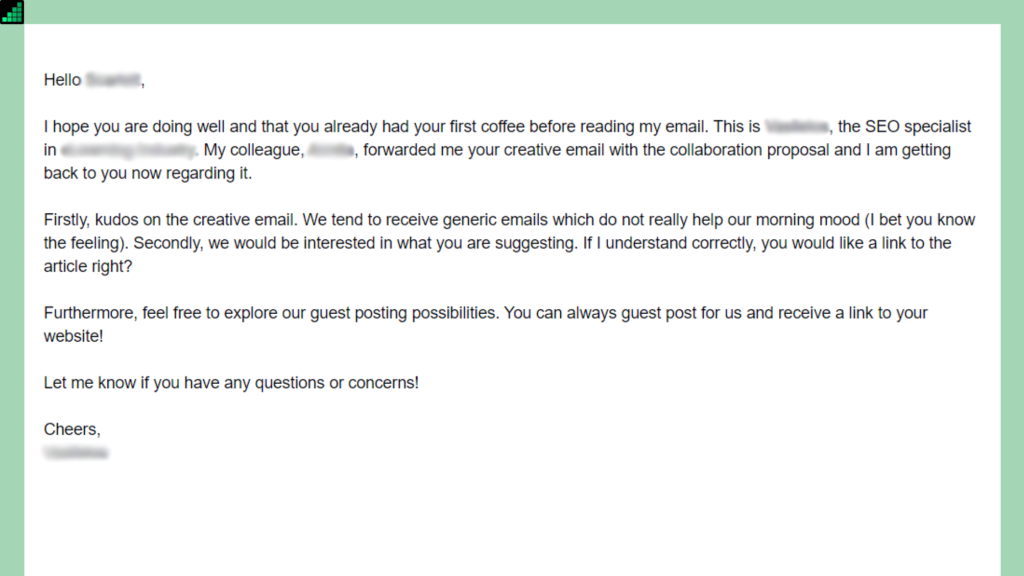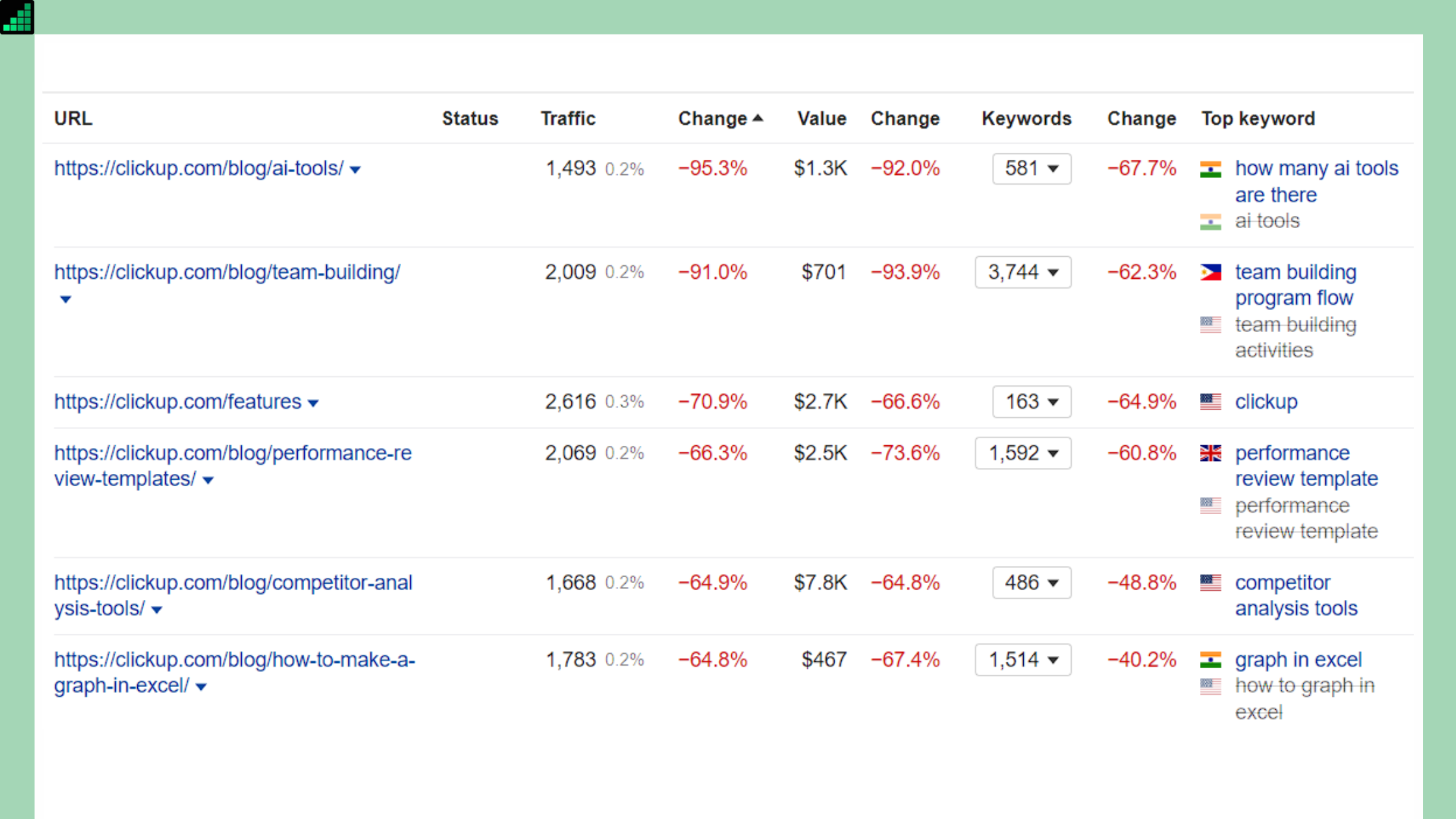Guest blogging is dead.
Or is it?
If we peel back the layers of Google’s leaked ranking systems, one thing is crystal clear: relevant, high-quality links from authority sites still matter. They’re a core signal driving your ability to rank in search results.
And guess what? Guest blogging, when executed strategically, is still one of the most effective ways to earn those links.
For startups, though, the challenge is real.
- Your domain rating is likely on the lower end.
- Your content library is thin (or non-existent).
- And getting noticed by high-authority sites feels like scaling a mountain in flip-flops.
Here’s the good news:
With the right approach, guest blogging can work wonders for startups. You just need a plan that prioritizes quality over quantity—one that brings measurable results without sacrificing credibility.
How do we know?
We’ve been at this for years. The strategies you’re about to learn aren’t fluff—they’re backed by real-world data from our client outreach campaigns. Every tip, every tactic has been tested and proven to work in today’s competitive digital landscape.
Ready to unlock guest blogging’s full potential for your startup?
Let’s get into it.
Why Guest Blogging Is Essential for Startups

Let’s get one thing straight:
Guest blogging is more than just a link-building tactic.
Sure, earning backlinks is the obvious benefit. And yes, backlinks help you:
- Rank higher on Google.
- Drive targeted traffic to your site.
- Turn that traffic into conversions.
But that’s just scratching the surface.
For startups, guest blogging is a multi-purpose powerhouse that pulls double duty as both a growth and PR strategy.
Here’s why it matters:
1. It Builds Credibility and Trust
When you’re the new kid on the block, getting potential customers, partners, or investors to trust you is no small feat. By contributing valuable content to established blogs in your niche, you gain instant credibility.
Think about it:
If your name is showing up on respected industry sites, people start to take notice. You’re no longer just a startup—you’re an authority.
2. It Opens Doors to New Opportunities
Guest blogging isn’t a one-and-done strategy. The value compounds.
Here’s how:
- You write one killer guest post.
- The site owner shares it with their audience or collaborators.
- Someone in their network takes notice—and invites you to write for them.
- OR – you use that killer guest post to help you land other guest posts.
It’s a domino effect. One post can lead to another, and before you know it, your product might be featured on multiple high-quality sites.
The key?
The network.

Guest blogging doesn’t just earn links; it builds relationships that can take your startup further than you’d ever expect.
3. It Brings Direct Traffic
Think guest posts only benefit your SEO? Think again.
When done right, a guest blog can bring direct traffic to your site—especially if it ranks well on Google.
I’ve seen this firsthand. After producing hundreds of guest posts at Growth Partners Media, many of those posts now hold top positions in search results. They continue to drive traffic, leads, and visibility to our clients long after they’re published.
4. It’s a Long-Term SEO Asset
Guest blogging isn’t about overnight success. It’s about playing the long game.
Each post you publish:
- Builds links that fuel your site’s authority.
- Showcases your expertise to a wider audience.
- Serves as a portfolio you can share with other blog editors.
Guest blogging positions your startup for long-term growth in search engine rankings.
It’s essential for startups because it builds credibility, traffic, and trust while expanding your network. It’s a strategy that works today, tomorrow, and likely will years from now.
You know what else are a now a long-term SEO and AI ranking asset? Forums. Check out the truth about forum backlinks and see how guest posts and forum links compare.
How to Identify Target Blogs and Key Niches

Before you dive into link-building outreach, you need a clear vision of what you’re aiming for.
Here’s the golden rule:
Never sacrifice quality.
One solid backlink from a relevant, high-authority blog will outperform dozens of low-quality links every single time.
One DR80 link can be worth as much as 10-100 DR40 links!
But what exactly does “quality” mean in this context? While there’s a lot of subjective noise around it, we focus on quantifiable metrics—the data-driven parameters that separate good opportunities from bad ones.
Let’s start from the very beginning and share our go-to method for sourcing blogs we want to target.
For this process, I’ll use Ahrefs as it’s the go-to SEO tool at Growth Partners Media.
1. Start with Keywords
Identify a list of keywords that align with your niche or target audience. You can use tools like:
- ChatGPT to generate keyword ideas.
- Ahrefs Keyword Generator for more structured options (pick your tool of choice).
After reviewing the list, I decided to go with logo AI generator as my keyword:

I then plugged this into Ahrefs’ Content Explorer tool:

2. Heavily Filter for Quality
Resist the temptation to reach out to every site you uncover. Instead, apply filters to zero in on high-quality, active websites. This saves time, effort, and ensures maximum impact.
Here are some filters we use at GPM:
- Publication date last 12 months – We don’t want to waste time reaching out to sites that aren’t actively publishing content. If you’re dealing with a highly competitive niche you might want to increase this number.
- Language English – We focus on creating content in English. Naturally, if your startup is targeting an audience speaking a specific language you’ll want to adjust this setting.
- Filter explicit content – We work only with SFW content. Stick to clean, professional websites.
- DR 40 to 90 – Adjust the lower threshold based on your current Domain Rating. Avoid chasing DR 90+ sites—they’re less likely to accept guest posts.
- Website Traffic 1,000 and more – This ensures the site is active and has real traffic. Depending on your niche, this minimum can be adjusted.
- Word count 1,000 and more – This might differ based on your niche, but you’ll want this to be at least 500.
This is what we’re left with:

From 14,233 pages down to 130 highly-targeted pages—filtered in seconds. That’s the top 1% of sites worth your attention (thanks to Ahrefs).
3. Export and Process Your Data
Click Export in Ahrefs to download your filtered list. Process it in Excel or Google Sheets for further analysis or outreach organization.
4. Find the Right Contact Person
Once you have your target sites, the next step is identifying the person responsible for content—usually an Editor, Content Manager, or Marketing Lead.
- Use tools like Apollo.io to find verified contact details quickly.
- Cross-check against your outreach database to ensure you haven’t pitched the same site before.
Bonus Tip: Maintain a central database of all outreach contacts to avoid duplication and streamline follow-ups.
Why This Process Works
We’ve fine-tuned this approach over hundreds of campaigns for clients, and it works because it prioritizes quality over quantity.
- You get fewer but better links.
- Your time is spent on opportunities that drive real results—traffic, authority, and conversions.
At the end of the day, low-quality links don’t move the needle. This workflow ensures you focus on what truly matters:
Links that deliver measurable ROI.
Crafting an Effective Guest Post Pitch

Now that you have a refined list of target sites, it’s tempting to hit send and hope for the best.
But let me stop you right there.
Never hit send and “hope for the best.”
A successful guest post pitch needs the perfect balance of personalization and scale.
Why personalization?
Because editors are drowning in generic, spammy pitches every single day. Standing out requires effort. A personalized email makes you look like a legitimate partner—someone worth collaborating with, not just another name in their inbox.
Why scale?
Because even the best campaigns get a modest 1–2% reply rate. You need to send enough pitches to generate meaningful results.
Let me show you what I mean with a quick analysis of a campaign we ran at GPM:
- We contacted 1,000+ site editors with personalized emails.
- We included two optimized follow-ups to boost response rates.
- Result? 11 replies—a 1.01% reply rate.
Let’s take a look at the graph below illustrating the scale of this:

That 1% may not sound impressive, but it only works because we put in the effort to make each email stand out. Imagine the outcome if we had emailed random editors with generic pitches.
Spoiler alert: The reply rate would have plummeted to 0.01%, and unsubscribes would have skyrocketed.
Here’s an example of what those 1% replies look like:

Not only did the editor respond, but we already started on the right foot. This is what success looks like when you craft a pitch that resonates.
Let’s pause here for a second.
If you’re suggesting writing a guest post for someone’s blog, your pitch must be impeccable. Think about it—if you can’t write an engaging, personalized email, why would they trust you to write entire blog post their audience will care about?
The Key to a Standout Pitch
Remember how I mentioned the portfolio of published guest posts earlier? Now’s the time to leverage it. Including links to your previous articles demonstrates credibility and reassures editors you know what you’re doing. It’s especially important when pitching to highly reputable blogs.
At this point, most guides would throw you a “plug-and-play” email template.
But here’s the problem:Templates are overused. Editors spot them a mile away.
Instead, I’ll give you something better—a universal checklist for crafting a winning pitch:
- Clear subject line: Catch their attention without sounding like clickbait.
- Brief introduction: Who are you, and why are you reaching out?
- A touch of humor: Break the ice, but keep it professional.
- Summary of your guest post idea: Make it personalized, concise, and relevant to their audience.
- Links to your previous articles: Show you’ve already published quality content elsewhere.
This checklist works for every pitch, but the magic comes from tailoring it to each editor.
As you can see, building high-quality links through guest blogging isn’t as easy as it looks. Every step—sourcing sites, crafting pitches, and following up—brings its own challenges.
It took us years of testing, optimizing, and systemizing to reach the level of consistency we operate at today.
If you don’t have that time to spare climbing the learning curve, we’ve got you covered.
Developing Guest Post Ideas that Win Approval

Remember when I emphasized the importance of reaching out to high-quality blogs? There’s just one catch—you’re not the only one doing it.
The better the blog, the more pitches they receive. Competition is fierce, and editors have no shortage of options.
You’ve already grabbed their attention with a killer email. Now it’s time to seal the deal with guest post ideas they can’t resist.
Here are the best guest blogging tactics for startups:
1. The Half-Way House
This is the most universal and evergreen approach to guest blogging—and it’s deceptively simple.
Your pitch should meet the blog editor halfway by aligning with both:
- Your startup’s niche
- Their blog’s audience and content focus
Here’s why this works:
- Editors are happy to receive free, relevant content that fits their site seamlessly.
- You control the topics you pitch, ensuring they’re both contextually relevant and valuable for your audience.
For example, an authority blog about dog food isn’t going to publish an article on “The Best AI Tools in 2025.” But if you pitch “How AI Is Revolutionizing Pet Nutrition,” you’ve struck the perfect balance.
Pro tip: Always check if your target blog has already covered the topic.
- If they have, don’t pitch it.
- If similar topics exist, it’s a good signal—just bring a fresh angle to the table.
This process is our bread and butter. Here’s an example of a guest post we wrote for LeadGen app. Blending lead conversion with content personalization strategies.
Please note I’ve handpicked this article to protect our author details, which we cannot reveal here. This example is ghostwritten.
2. The Refresh
Maintaining blog content becomes more difficult with each published post.
The site editor(s) must keep an eye on any outdated info or decaying content. What if you could help them out?
Instead of proposing new topics for their site, you can offer to update an existing piece. This is the shortest explanation of the refresh angle.
Here’s how to identify those opportunities using Ahrefs’ Site Explorer:
Input the target site domain and hit search:

Locate the Organic search section in the left sidebar and select Top pages:

Change the compare filter to the Previous year option:

Hit the Change column to filter the pages with the biggest traffic drop. (You might have to click it two times.)

Now you can see the list of pages that lost traffic and ranking since the last year:

Now you’ve got a list of pages that lost traffic and rankings over the past year.
Pitch improvements that will bring the post back to life:
- Add new tools or solutions that have emerged.
- Update outdated data or processes.
- Refresh examples or visuals to reflect current trends.
This approach highlights your industry expertise and demonstrates that you’re proactive about solving their problems. You don’t need to be the best writer or SEO guru—your up-to-date industry knowledge is what sets you apart.
3. The Seasonal Angle
Sometimes, the secret to getting your pitch accepted is timing.
The seasonal angle leverages timely, trend-focused topics that address an immediate audience need. It creates urgency—making it nearly impossible for editors to say no.
For example, if November’s around the corner, editors will prioritize your Black Friday pitch over evergreen topics.
Here’s how to nail this approach:
- Use tools like Google Trends or BuzzSumo to uncover trending topics.
- Analyze traffic spikes for specific timeframes using Ahrefs.
If you already have a great topic in mind, give it a seasonal twist.
- Instead of pitching “Top Productivity Hacks,” frame it as “Top Productivity Hacks for the Holiday Season.”
Here’s a practical example:
The term “AI for Gifts” consistently spikes in late November and early December, according to Google Trends:

Source: Google Trends
When pitching seasonal content, focus heavily on the timeline:
- Mention the seasonality in your subject line.
- Highlight it in the introduction.
- Make it crystal clear why the timing is perfect for their audience.
Editors love timely pitches because they address immediate audience interests and can be slotted into their content calendar with ease.
4. The Pillar Post Promoter
While adding internal links in your guest post is a nice touch that editors appreciate, you can take it a step further and build your entire pitch around it.
This strategy we devised is called the Pillar Post Promoter – and it focuses on creating a complementary guest post that benefits both your brand and the host blog.
Here’s how it works:
- You identify a high-performing article on the host blog.
- You propose a new guest post that naturally links back to that article.
The result? The host blog gets fresh, relevant content with strategic internal links, while you secure your backlink.
To find these opportunities, you can follow a similar process to the Refresh technique. The difference here is you’ll focus on pages that are already gaining traffic and rankings rather than losing them.
Pro Tip: Use tools like Ahrefs (our preferred choice) or SEMrush to identify these top-performing pages.
A great place to start is listicles. For example, if the host site has a post titled “The Top 10 Tools for Boosting Workplace Productivity,” you could pitch a complementary piece like “How to Integrate the Top Productivity Tools for Maximum Efficiency.”
This approach adds value by providing actionable insights that expand on their existing content, while also naturally linking back to the original post.
5. The Kaleidoscope
The Kaleidoscope strategy is where creativity meets precision—a balanced mix of the Pillar Post Promoter and Refresh techniques.
The idea?
Repurpose an existing topic to appeal to a specific audience.
Here’s what that looks like in practice:
- Let’s say the host blog has a piece titled “Top Digital Marketing Trends.”
- You pitch a hyper-focused variation, like “Digital Marketing Trends for Real Estate Startups.”
It’s the same core topic but reimagined for a niche audience.
The catch? Executing this strategy requires two key things:
- Industry Expertise: You need in-depth knowledge of the specific angle you’re pitching. For instance, knowing SaaS marketing trends doesn’t mean you can write about trends in real estate or healthcare marketing.
- Strong Writing Skills: A successful Kaleidoscope post demands more than surface-level adjustments. The writer must transform tone, style, and terminology to resonate with the targeted audience seamlessly.
When done well, this strategy positions you as an expert across niches, while helping the host blog reach new segments of their audience.
Tracking Results and Optimizing Future Guest Blogging Efforts

If you’ve made it through sourcing blogs, crafting pitches, and delivering quality guest posts, congratulations—you’re on the right track.
But your work isn’t done yet.
To maximize the impact of your efforts, you need to track your results and optimize future outreach.
- Maintain a Database of Contacts
Keep a centralized log of all the sites you’ve pitched and collaborated with. This ensures you won’t waste time reaching out to the same leads twice. Take it a step further by tracking submitted and active posts to stay organized.
- Measure Guest Post Performance
Use SEO tools like Ahrefs or SEMrush to track how your rankings respond to the links you’ve built. These tools also help monitor the guest post’s performance in search results over time.
This gives you clear insights into what’s working and where you need to improve.
- Log Your Pitches
Maintaining a pitch log lets you analyze the success of your outreach experiments. Identify which topics or angles got approved and which ones didn’t.
If some of the pitches get rejected you can always repurpose them. Don’t forget to improve them though.
At GPM, we take tracking and optimization seriously. After years of testing and refining, we’ve built a reliable system that handles every step—from outreach to post-monitoring—with precision.
Beyond the system, we’ve developed direct partnerships with hundreds of top publicists and editors. For us, guest blogging isn’t just outreach—it’s about creating ongoing collaborations that deliver long-term results for clients.
If you need a hand with your guest posts, we’re an option you may want to consider. With our expertise, you’ll be scoring high-quality guest post backlinks within weeks—not months.
If you’re interested in other ways to acquire backlinks, check out our comprehensive piece on link building for saas.
Conclusion
The key to successful guest blogging for startups lies in quality and consistency.
It starts with identifying the best blogs in your niche and developing unique, relevant content ideas that editors can’t ignore. From there, it’s about experimenting, refining, and replicating your process to build sustainable results.
Guest blogging isn’t just about links—it’s about creating a network, building credibility, and driving meaningful traffic to your site.
The strategies outlined here come from years of hands-on experience and real-world results we’ve achieved for our clients.
But here’s the thing: Guest blogging isn’t a quick fix.
It’s a 12-month SEO marathon. If you’re ready to commit to the process, the rewards are well worth it!
- How to Outsource Backlink Building Without Stress [2025] - October 7, 2025
- Top 3 SEO Outreach Services That Actually Work [2025] - October 7, 2025
- 9 White-Hat Link Building Techniques For AI & Google (2025) - September 23, 2025



